Page 492 - Handbook Of Integral Equations
P. 492
can be represented in the form of a product
n
y(x) – Q [y] ≡ 1 – L k [y], (35)
k=1
where the L k are linear operators. Suppose that the solutions of the auxiliary equations
y(x) – L k [y]= f(x), k =1, ... , n (36)
are known and are given by the formulas
y(x)= Y k f(x) , k =1, ... , n. (37)
The solution of the auxiliary equation (36) for k = n, in which we apply the substitution y → y n–1 ,
is given by the formula y n–1 (x)= Y n f(x) . Reasoning similar to that used in Subsection 9.4-3
shows that the solution of Eq. (34) can be reduced to the solution of the simpler equation
n–1
1 – L k [y]= y n–1 (x).
k=1
Successively reducing the order of the equation, we eventually arrive at an equation of the form (36)
for k = 1, whose right-hand side contains the function y 1 (x)= Y 2 y 2 (x) . The solution of this
equation is given by the formula y(x)= Y 1 y 1 (x) .
The solution of the original equation (35) can be defined recursively by the following formulas:
y k–1 (x)= Y k y k (x) ; k = n, ... , 1, where y n (x) ≡ f(x), y 0 (x) ≡ y(x).
Note that here the decreasing sequence k = n, ... , 1 is used.
•
Reference for Section 9.4: A. D. Polyanin and A. V. Manzhirov (1998).
9.5. Construction of Solutions of Integral Equations With
Special Right-Hand Side
In this section we describe some approaches to the construction of solutions of integral equations
with special right-hand side. These approaches are based on the application of auxiliary solutions
that depend on a free parameter.
9.5-1. The General Scheme
Consider a linear equation, which we shall write in the following brief form:
L [y]= f g (x, λ), (1)
where L is a linear operator (integral, differential, etc.) that acts with respect to the variable x and is
independent of the parameter λ, and f g (x, λ) is a given function that depends on the variable x and
the parameter λ.
Suppose that the solution of Eq. (1) is known:
y = y(x, λ). (2)
Let M be a linear operator (integral, differential, etc.) that acts with respect to the parameter λ
and is independent of the variable x. Consider the (usual) case in which M commutes with L.We
apply the operator M to Eq. (1) and find that the equation
L [w]= f M (x), f M (x)= M f g (x, λ) , (3)
has the solution
w = M y(x, λ) . (4)
By choosing the operator M in a different way, we can obtain solutions for other right-hand
sides of Eq. (1). The original function f g (x, λ) is called the generating function for the operator L.
© 1998 by CRC Press LLC
© 1998 by CRC Press LLC
Page 474

